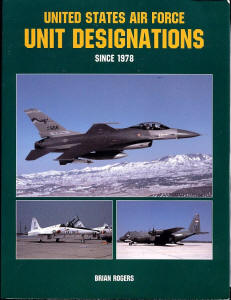|
Specialty Press |
|
United States Air Force Unit Designations Since 1978 |
|
by Brian Rogers |
|
Reviewed By Jim Pearsall, #2209 |
|
|
|
MSRP: $44.95 USD Available from Specialty Press: 39966 Grand Ave, North Branch, MN, 55056 The basics: Softbound, 8 ½ X 11 inches, 260 pages, with 50 color photos. I want to thank Specialty Press for sending this review copy. The Contents: the first thing I did when I got this book was open it and find the ANG unit I was with for a long time. It’s in there. It’s correct. OK. But the question came up in my mind, “Why 1978?” Well, there’s obviously the answer that if it went from 1947, it’d be about 6 inches thick. But the REAL answers are:
The book is strictly a reference work, laid out with page after page of tabular information (a tabular is a table without a table title, but I digress). And it’s pretty easy to use. It has the information, and even I could figure it out in minutes. How it’s laid out:
There are two appendices, one with tail markings, the other with Unit Designator & tail codes. Since this is the info most of us want to find quickly, it’s very handy. Conclusion: This is another of those labors of love. This information is probably available somewhere, but finding it can be a real chore. If you’re into USAF grey jets, this book was compiled for you. It’s a single source for who flies what, where they’re based, what they were called before. Also, the tail markings and tail codes are something no one else pays much attention to. This is definitely a book for the niche enthusiast. But if you’re in that niche, I suggest you have serious thoughts about how you’re going to get this book. |
|
Information, images, and all
other items placed electronically on this site |
